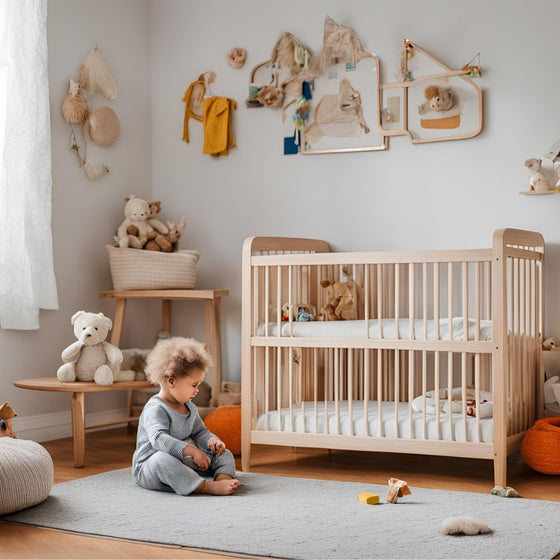Transitioning from a crib to a bed is an exciting milestone for both toddlers and parents. Understanding when do toddlers sleep in a bed is crucial for making this process smooth and successful. This period often signifies a step towards independence and growth, raising questions about the right timing and approach.
Parents frequently express concerns such as:
1. What age can a toddler sleep in a twin bed?
2. How to introduce a toddler bed?
3. Will my child adjust smoothly to the new sleeping arrangement?
Addressing these questions helps ensure that the transition is safe, comfortable, and positive for your little one.
Understanding Toddler Sleep Needs
Overview of Toddler Sleep Patterns and Needs
Toddlers typically require around 11 to 14 hours of sleep within a 24-hour period, including naps. Their sleep patterns can vary significantly as they navigate developmental milestones. Establishing a routine is crucial to ensure they get the rest they need.
Importance of Consistent Bedtime Routines for Healthy Sleep Habits
A consistent bedtime routine can be a game-changer in addressing toddler sleep issues. Activities such as reading a book, taking a warm bath, or listening to soothing music help signal to your child that it's time to wind down. This predictability fosters a sense of security and promotes better sleep quality.
Signs That Indicate a Toddler Is Ready for a Bed Transition
Transitioning from a crib to a bed is an important milestone in your toddler's development. Key signs that your child may be ready include:
• Climbing out of the crib - If your toddler starts climbing out, it might be time to consider a toddler bed.
• Height considerations - Once they reach about 35 inches in height, the crib may no longer be safe.
• Showing interest in a "big kid bed" - Expressing curiosity or excitement about sleeping in a larger bed is another positive indicator.
Recognizing these signs helps ensure that the shift to a new bed happens smoothly and at the right time for your child's developmental readiness.
This understanding sets the foundation for knowing when and how to introduce a toddler bed, making the transition seamless and less stressful for both parents and children.
When Do Toddlers Sleep in a Bed?
Determining the right time for moving from crib to bed can be a major milestone for both parents and toddlers. Typically, toddlers transition between 18 months to 3 years. This age range allows flexibility based on individual readiness and developmental cues.
Key indicators of readiness include:
• Climbing out of the crib - If your toddler is starting to climb out, it’s a safety risk and a clear sign they might be ready for a bed.
• Height considerations - When your child reaches about 35 inches in height, they may be too tall for the crib.
• Expressing interest - Some children will show enthusiasm or curiosity about a "big kid bed."
Individual experiences vary. For instance:
Emily noticed her 2-year-old son, Max, trying to climb out of his crib repeatedly. This prompted her to transition him to a toddler bed earlier than she originally planned.
Sara's daughter, Lily, started talking about wanting a "princess bed" at around 2.5 years old. Sara took this as an opportunity to involve Lily in the selection process, which made the transition smoother.
Parents often wonder what age can a toddler sleep in a twin bed. While some may move directly from the crib to a twin bed as early as 18 months if the child shows signs of readiness, others might wait until closer to 3 years or even older. The key is observing your child's cues and ensuring safety measures are in place.
Understanding these indicators helps parents make informed decisions tailored to their child's unique needs and readiness.
Types of Beds for Toddlers
Choosing the right bed for your toddler can greatly impact their comfort and sense of security. Here are the primary options to consider:
1. Toddler Bed

Designed specifically for toddlers, these beds are low to the ground and often come with built-in guardrails. They usually use the same mattress size as a crib, making the transition easier.
Pros:
• Safety - Low height reduces the risk of injury from falls.
• Familiarity - Uses a crib mattress, which can make the transition smoother.
• Designs - Often available in fun themes that can excite toddlers.
Cons:
• Limited Use - Toddlers may outgrow these beds quickly.
• Additional Cost - May require purchasing another bed in a few years.
2. Twin Beds
Larger than toddler beds and typically used with a twin-size mattress. Suitable for longer-term use as they accommodate growth over several years.
Pros:
• Longevity - Can be used well into childhood, reducing the need for another transition.
• Versatility - More options available in terms of styles and designs.
Cons:
• Safety Concerns - Higher off the ground, increasing fall risk without proper guardrails.
• Initial Adjustment - May seem too large or unfamiliar to some toddlers initially.
3. Skipping the Toddler Bed

Some parents opt to skip the toddler bed entirely and move directly to a twin bed. This decision can be influenced by factors like:
1. Child's Size & Development - If your toddler is already nearing the weight limit for a toddler bed (around 50 pounds) or seems uncomfortable in their current sleeping arrangement, transitioning straight to a twin bed might be wise.
2. Personal Preferences - Some children express excitement about moving into a "big kid" bed, which can ease the transition.
When deciding between a toddler bed and a twin bed, consider your child's specific needs and preferences. Ensuring safety with guardrails and choosing a bed they are excited about can help facilitate a smoother transition.
Preparing for the Transition
Ensuring a smooth transition to a new bed requires careful preparation and attention to detail. Below are key steps to make this change as seamless as possible for your toddler:
Steps to Prepare the Room
Safety is paramount when transitioning your child to a new bed. Here are some essential safety measures:
Guardrails - Install guardrails on the sides of the bed to prevent falls.
Bed Placement - Position the bed away from windows, heaters, and electrical outlets.
Clear Floor Space - Remove any clutter or toys around the bed area to prevent tripping hazards.
Involving Your Child in the Selection Process
Making your toddler part of this exciting change can foster enthusiasm and cooperation. Here’s how you can involve them:
Establishing a consistent bedtime routine is essential for promoting healthy sleep habits in toddlers. Engaging in calming activities like reading, taking a warm bath, or listening to soothing music signals to your child that it's time to wind down, helping them transition from the day's energy to a more relaxed state. This predictability creates a sense of security, making bedtime a comforting and familiar part of their day.
A regular bedtime routine also helps regulate your child's circadian rhythm, leading to quicker sleep onset and improved sleep quality. Over time, this routine reduces bedtime resistance and nighttime awakenings, teaching your child the valuable skill of self-soothing and fostering their overall growth and well-being.
Signs That Indicate a Toddler Is Ready for a Bed Transition
Transitioning from a crib to a bed is an important milestone in your toddler's development. Key signs that your child may be ready include:
Climbing out of the crib - If your toddler starts climbing out, it might be time to consider a toddler bed.
Height considerations - Once they reach about 35 inches in height, the crib may no longer be safe.
Showing interest in a "big kid bed" - Expressing curiosity or excitement about sleeping in a larger bed is another positive indicator.
Recognizing these signs helps ensure that the shift to a new bed happens smoothly and at the right time for your child's developmental readiness.
This understanding sets the foundation for knowing when and how to introduce a toddler bed, making the transition seamless and less stressful for both parents and children.
Maintaining Familiar Bedtime Routines
Consistency is crucial in easing the transition. Keep these routines intact:
Same Bedtime Rituals - Continue with familiar bedtime stories, songs, or prayers.
Comfort Items - Ensure their favorite blanket or stuffed animal is with them in the new bed.
By following these steps, parents can address common safety concerns and make the transition bed experience positive and enjoyable for their toddlers.
Strategies for Easing the Transition
Practical Tips for Making the Switch Smoother
Create a Consistent Bedtime Routine - Establishing a predictable bedtime routine helps signal to your toddler that it's time to wind down. This could include activities like a warm bath, reading a book, or singing lullabies.
Introduce the Bed Gradually - Allow your child to get accustomed to their new bed by letting them play on it during the day. This can make it feel more familiar and less intimidating.
Positive Reinforcement - Praise and rewards can go a long way. Commend your child for spending the night in their new bed or offer small incentives like stickers or an extra bedtime story.
What to Avoid
Timing with Major Life Changes - Avoid transitioning during significant disruptions like moving homes, starting daycare, or welcoming a new sibling. These changes can add stress and make the transition more challenging.
Inconsistent Routines - Try not to deviate from established bedtime routines. Consistency is key in helping your toddler feel secure and understand what is expected.
Encouraging Comfort and Security
Keep Comfort Items Close - Familiar blankets, stuffed animals, or even a piece of clothing that smells like you can provide comfort and security.
Nightlights and White Noise Machines - These tools can make the transition easier by providing a soothing environment. A dim nightlight can help alleviate fears of the dark, while white noise machines can drown out unfamiliar sounds.
Open Communication - Talk with your child about their new bed. Encourage them to express any fears or anxieties they might have, offering reassurance and understanding.
Conclusion
Successfully transitioning your toddler from a crib to a bed is a significant milestone that requires careful planning and understanding of your child’s unique needs. By recognizing the signs of readiness, choosing the right type of bed, and maintaining consistent bedtime routines, you can ensure a smooth and positive experience for both you and your little one.
Remember, each child is different, and what works for one may not work for another. Patience, flexibility, and a little creativity can make all the difference in this important stage of their development. As you guide your toddler through this transition, you’re not just helping them sleep better—you’re fostering their growth, independence, and confidence.








